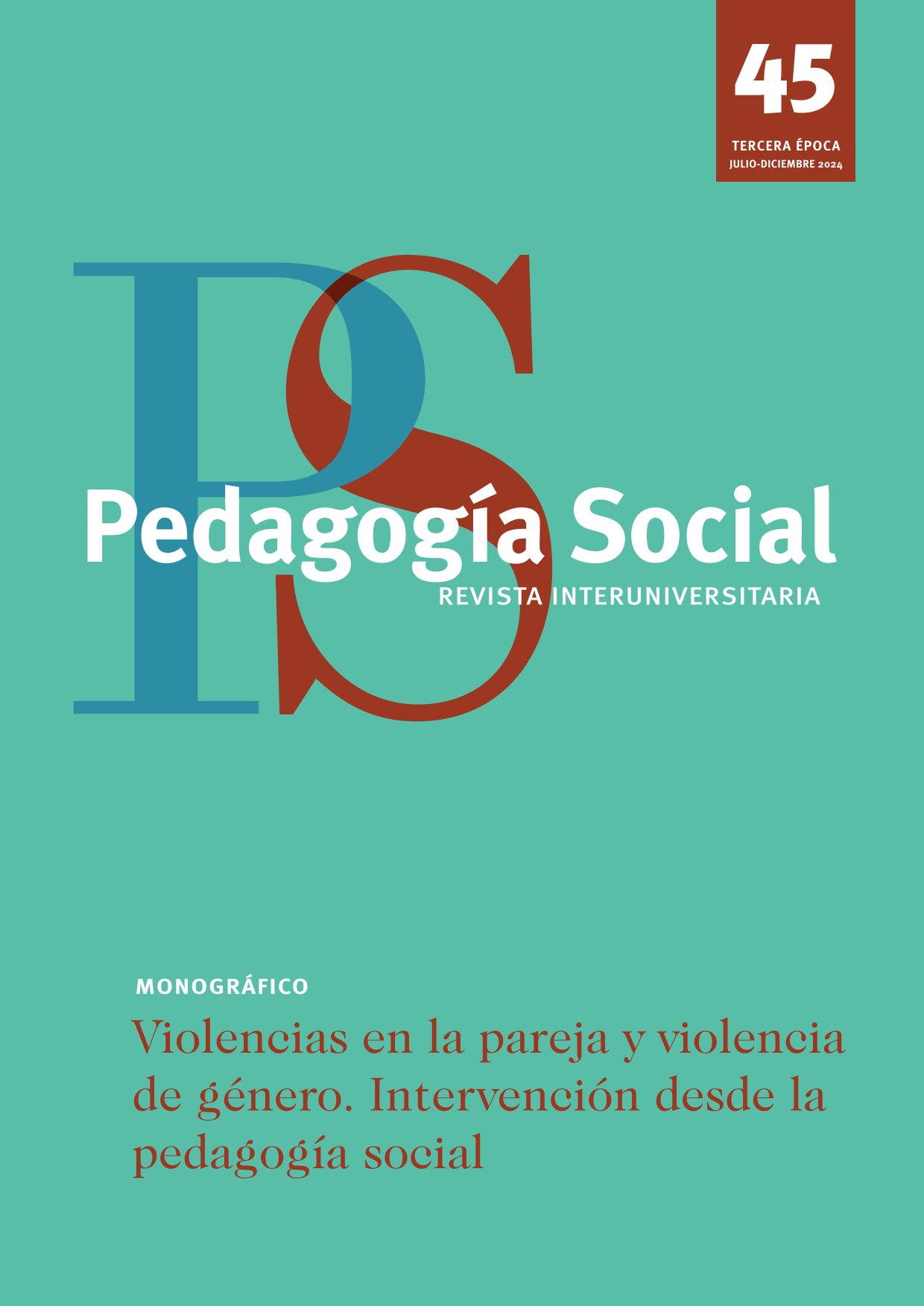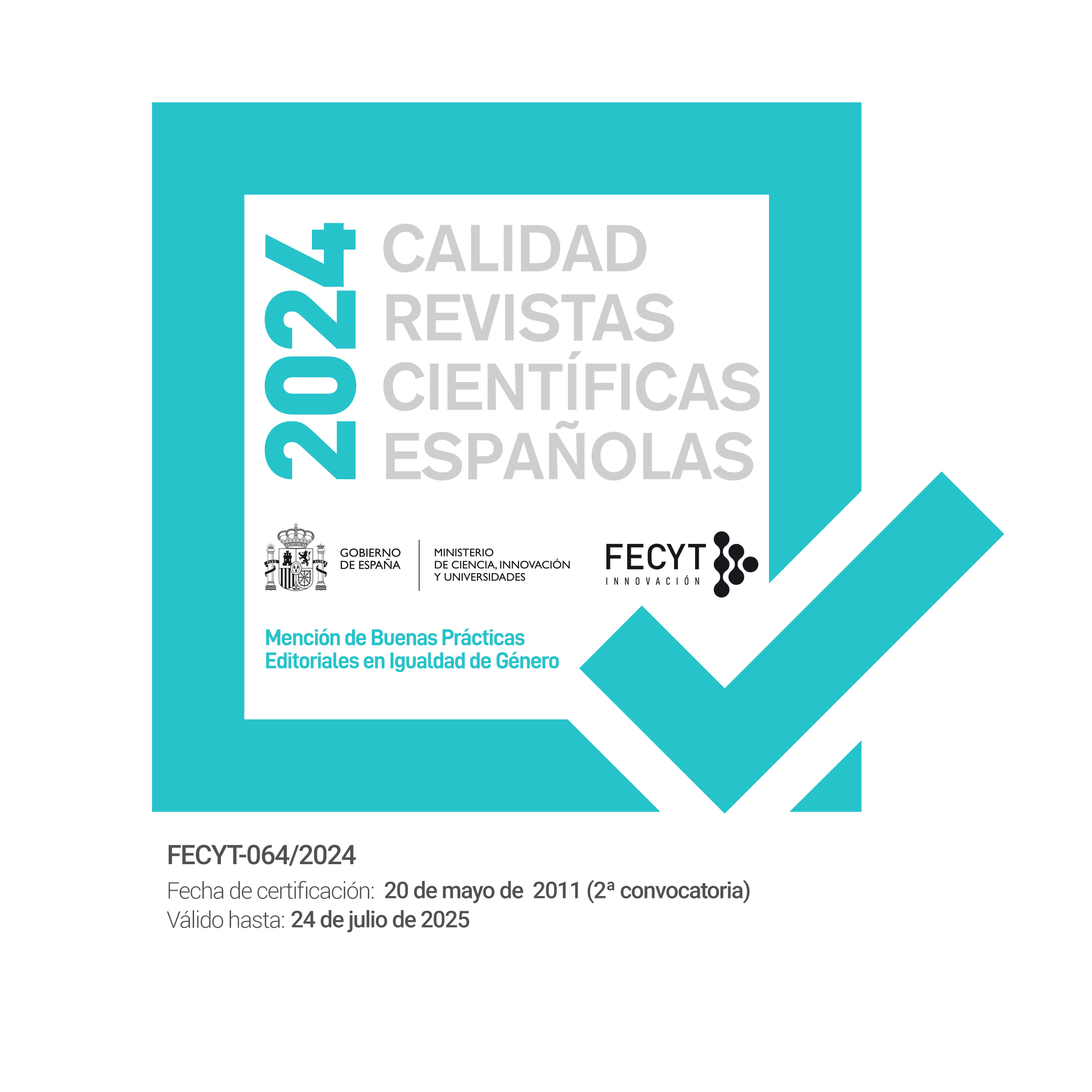Análisis configuracional de la denuncia de violencia en parejas de mujeres sexodisidentes
DOI:
https://doi.org/10.7179/PSRI_2024.45.06Palabras clave:
Violencia, homosexualidad, condiciones económicas, interseccionalidad, csQCA, CEMResumen
Este artículo tiene como objetivo identificar las condiciones necesarias y suficientes para la denuncia de violencia de pareja íntima (VPI) entre parejas de mujeres sexodisidentes. Para ello, se analizan los casos de denuncia y no denuncia de violencia física y violencia económica utilizando datos del Banco Nacional de Datos e Información sobre Casos de Violencia contra las Mujeres. Estos datos fueron preprocesados con Coarsened Exact Matching para reducir posibles sesgos. La submuestra resultante se sometió a Análisis Cualitativo Comparado (csQCA), dada la evidencia previa que sugiere una causalidad asimétrica, coyuntural y múltiple en el problema. El estudio revela varias configuraciones causales alternativas para la no denuncia, pero pocas para la denuncia. El empleo de la parte agresora y la propiedad de la vivienda por parte de la pareja son condiciones necesarias para la no denuncia de violencia económica. En cuanto a la no denuncia de violencia física, cuatro condiciones son destacadas, la propiedad de la vivienda, el empleo de la parte agresora, la presencia de otras formas de violencia y la falta de empleo de la víctima. La estructura predominante fomenta la proliferación de la violencia contra aquellos que carecen de seguridad económica. A través del control económico, la parte agresora limita las posibilidades de que la víctima busque ayuda y se sirve del miedo. Este estudio evidencia la configuración de las relaciones de poder en la pareja, las cuales pueden ser transformadas a través de la educación. Asimismo, contribuye a la pedagogía crítica al analizar las estructuras de poder y promover la justicia social.
Descargas
Citas
Alanez, D., y Jarro, A. (2022). Relaciones de poder y violencia intragénero en parejas lesbianas: ¿Quién es el hombre de la relación? Journal de Comunicación Social, 14(14), 79-104.
Alhusen, J. L., Lucea, M. B., y Glass, N. (2010). Perceptions of and experience with system responses to female same-sex intimate partner violence. Partner abuse, 1(4), 443-462.
Ard, K. L., y Makadon, H. J. (2011). Addressing intimate partner violence in lesbian, gay, bisexual, and transgender patients. Journal of general internal medicine, 26, 930-933.
Bermea, A. M., Slakoff, D. C., y Goldberg, A. E. (2021). Intimate Partner Violence in the LGBTQD Community. Prim Care Clin Office Pract.
Bettinger, T. V. (2010). Ethical and methodological complexities in research involving sexual minorities. New Horizons in Adult Education and Human Resource Development, 24(1), 43-58.
Bhalotra, S., Kambhampati, U., Rawlings, S., y Siddique, Z. (2021). Intimate Partner Violence: The Influence of Job Opportunities for Men and Women. The World Bank Economic Review, 35(2), 461-479. https://doi.org/10.1093/wber/lhz030
Blosnich, J. R., y Bossarte, R. M. (2009). Comparisons of intimate partner violence among partners in same-sex and opposite-sex relationships in the United States. American journal of public health, 99(12), 2182-2184.
Callan, A., Corbally, M., y McElvaney, R. (2021). A scoping review of intimate partner violence as it relates to the experiences of gay and bisexual men. Trauma, Violence, y Abuse, 22(2), 233-248.
Calton, J. M., Cattaneo, L. B., y Gebhard, K. T. (2016). Barriers to help seeking for lesbian, gay, bisexual, transgender, and queer survivors of intimate partner violence. Trauma, violence, y abuse, 17(5), 585-600.
Canedo, A. P., y Morse, S. M. (2021). An Estimation of the Effect of Women’s Employment on the Prevalence of Intimate Partner Violence in Mexico. Journal of Interpersonal Violence, 36(19-20), NP10594-NP10618. https://doi.org/10.1177/0886260519876016
Cantú Cantú, Z., y Martínez Galán, A. (2023). Lesbofobia en la familia nuclear: Un desamparo ante la violencia en las lesbofamilias. Albores, 2(2), 21-35.
Colombo, G., Schmukler, B. E., y Sosa, R. (2019). Teoría Social y Políticas Públicas interpeladas por las epistemologías y metodologías feministas: Eslabones conceptuales para una sociología reflexiva a partir de narrativas y de escenarios de lo cotidiano. Revista Conjeturas Sociológicas, 41-61.
Copi, I. M., y Cohen, C. (2019). Introducción a la lógica (Segunda). Limusa.
Cortés-González, P., Martín-Solbes, V. M., y Vila-Merino, E. S. (2023). Pedagogía social y evaluación de los servicios sociales comunitarios: un caso de estudio. Pedagogía Social. Revista Interuniversitaria, 42, 121-134
Crenshaw, K. (1990). Mapping the margins: Intersectionality, identity politics, and violence against women of color. Stan. L. Rev., 43, 1241.
Deaño, A. (2009). Introducción a la lógica formal. Alianza Editorial.
Donovan, C., y Barnes, R. (2020). Help-seeking among lesbian, gay, bisexual and/or transgender victims/survivors of domestic violence and abuse: The impacts of cisgendered heteronormativity and invisibility. Journal of Sociology, 56(4), 554-570. https://doi.org/10.1177/1440783319882088
Dusa, A. (2022). QCA with R. A Comprehensive Resource 2022-08-21. Springer. https://www.bookdown.org/dusadrian/QCAbook/QCAbook.pdf
Dutton, D. G. (2012). The case against the role of gender in intimate partner violence. Aggression and violent behavior, 17(1), 99-104.
Edward, M., y Greenough, C. (2020). Queer Literacy: Visibility, Representation, and LGBT+ Research Ethics. Handbook of Research Ethics and Scientific Integrity, 707-718.
Edwards, K. M., Sylaska, K. M., y Neal, A. M. (2015). Intimate partner violence among sexual minority populations: A critical review of the literature and agenda for future research. Psychology of violence, 5(2), 112.
Frías, S. (2008). Diferencias regionales en violencia doméstica en México: El rol de la estructura patriarcal. En Estudios sobre cultura, género y violencia contra las mujeres (pp. 81-136.). CRIM, Centro Regional de Investigaciones Multidisciplinarias, UNAM, Universidad Nacional Autónoma de México. http://bibliotecavirtual.clacso.org.ar/Mexico/crim-unam/20100329121733/Estudiossobr eculturagenero.pdf
Frías, S. (2013). Strategies and Help-Seeking Behavior Among Mexican Women Experiencing Partner Violence. Violence Against Women, 19(1), 24-49. https://doi.org/10.1177/1077801212475334
Robinson, S. R., Ravi, K., y Voth Schrag, R. J. (2021). A Systematic Review of Barriers to Formal Help Seeking for Adult Survivors of IPV in the United States, 2005-2019. Trauma, Violence y Abuse, 22(5), 1279-1295. https://doi.org/10.1177/1524838020916254
Rodríguez Otero, L., Castro, Y., María, L., y Carrera-Fernández, M. V. (2017). Violencia en parejas Gays, Lesbianas y Bisexuales: Una revisión sistemática 2002-2012. Comunitania. Revista Internacional de Trabajo Social y Ciencias Sociales, 49. https://doi.org/10.5944/comunitania.13.3
Roffee, J. A., y Waling, A. (2017). Resolving ethical challenges when researching with minority and vulnerable populations: LGBTIQ victims of violence, harassment and bullying. Research Ethics, 13(1), 4-22.
Rohrbaugh, J. B. (2006). Domestic violence in same-gender relationships. Family court review, 44(2), 287-299.
Rollè, L., Giardina, G., Caldarera, A. M., Gerino, E., y Brustia, P. (2018). When Intimate Partner Violence Meets Same Sex Couples: A Review of Same Sex Intimate Partner Violence. Frontiers in Psychology, 9, 1506. https://doi.org/10.3389/fpsyg.2018.01506
Rondan Pumachagua, L.-B., Rojas Vargas, S., Cruz-Manrique, Y. R., y Malvaceda-Espinoza, E. L. (2022). Violencia íntima de pareja en lesbianas, gais y bisexuales de Lima Metropolitana. Revista de Investigación en Psicología, 25, 105-120.
San Román Tajonar, G. (2023). Determinantes locales y regionales de la denuncia de violencia familiar en México. Dilemas Contemporáneos: Educación, Política y Valores, X(2), 1-31. https://doi.org/10.46377/dilemas.v2i10.3543
San Román Tajonar, G., y Olivares-Méndez, M. (2024). Tipología de víctimas de violencia de pareja: Comparación entre mujeres sobrevivientes heterosexuales y lesbianas. Dilemas contemporáneos: Educación, Política y Valores.
Santoniccolo, F., Trombetta, T., y Rollè, L. (2023). The Help-Seeking Process in Same-Sex Intimate Partner Violence: A Systematic Review. Sexuality Research and Social Policy, 20(1), 391-411. https://doi.org/10.1007/s13178-021-00629-z
Scheer, J. R., Lawlace, M., Cascalheira, C. J., Newcomb, M. E., y Whitton, S. W. (2023). Help-seeking for severe intimate partner violence among sexual and gender minority adolescents and young adults assigned female at birth: A latent class analysis. Journal of interpersonal violence, 38(9-10), 6723-6750.
Schmukler, B.E. (2020) La democratización familiar y la pedagogía de los conocimientos situados. En García Falconi, S. y Hernández Pérez, A. (Eds) Género y prevención de la violencia en la familia y la comunidad. UAQ.
Schmukler, B. E. (2013). Democratización familiar como enfoque de prevención de violencia de género: experiencias en México. Revista Latinoamericana de Estudios de Familia, 5, 199-221.
Schneider, C. Q., y Wagemann, C. (2010). Standards of Good Practice in Qualitative Comparative Analysis (QCA) and Fuzzy-Sets. Comparative Sociology, 9(3), 397-418. https://doi.org/10.1163/156913210X12493538729793
Schneider, C., y Wagemann, C. (2012). Set-Theoretic Methods for the Social Sciences. A Guide to Qualitative Comparative Analysis. Cambridge University Press.
Sherman, A. D., Allgood, S., Alexander, K. A., Klepper, M., Balthazar, M. S., Hill, M., Cannon, C. M., Dunn, D., Poteat, T., y Campbell, J. (2022). Transgender and gender diverse community connection, help-seeking, and mental health among Black transgender women who have survived violence: A mixed-methods analysis. Violence against women, 28(3-4), 890-921.
Steele, S. M., Everett, B. G., y Hughes, T. L. (2020). Influence of perceived femininity, masculinity, race/ethnicity, and socioeconomic status on intimate partner violence among sexual-minority women. Journal of Interpersonal Violence, 35(1-2), 453-475.
Turner, R., y Hammersjö, A. (2023). Navigating survivorhood? Lived experiences of social support-seeking among LGBTQ survivors of intimate partner violence. Qualitative Social Work, 14733250221150208.
Vázquez Soriano, M. A. (2023). El Análisis Cualitativo Comparado (QCA) y el estudio del cambio político en América Latina. Espiral Estudios sobre Estado y sociedad (eISSN: 2594-021X), 30(86). http://www.espiral.cucsh.udg.mx/index.php/EEES/article/view/7350
Vidales, G. T. (2010). Arrested justice: The multifaceted plight of immigrant Latinas who faced domestic violence. Journal of Family Violence, 25, 533-544.
Voth Schrag, R. J. y Edmond, T. E. (2018). Service use and needs among female survivors of intimate partner violence attending community college. Journal of family violence, 33, 393-404.
Wagemann, C. y Schneider, C. (2015). Transparency standards in qualitative comparative analysis. Qualitative y Multi-Method Research, 13(1), 38-42. https://doi.org/10.5281/zenodo.893091
Whitton, S. W., Devlin, E. A., Lawlace, M., y Newcomb, M. E. (2024). Disclosure and help-seeking experiences of sexual and gender minority victims of intimate partner violence: a mixed-methods study. Journal of interpersonal violence, 39(7-8), 1373-1397
Xie, M. y Baumer, E. P. (2019). Crime Victims’ Decisions to Call the Police. Past Research and New Directions, 2, 217-240. https://doi.org/10.1146/annurev-criminol-011518-024748
Publicado
Cómo citar
Número
Sección
Licencia

Esta obra está bajo una licencia internacional Creative Commons Atribución-NoComercial-CompartirIgual 4.0.
Derechos de reproducción y archivo
La versión publicada de los artículos podrá ser autoarchivada por sus autores en repositorios institucionales y temáticos de acceso abierto. No obstante la reutilización total o parcial de los mismos en nuevos trabajos o publicaciones deberá ser autorizada por Pedagogía Social. Revista Interuniversitaria.
Los trabajos publicados deberán ser citados incluyendo el título de la Revista, Pedagogía Social. Revista Interuniversitaria, nº, páginas y año de publicación.
Responsabilidades éticas
Pedagogía Social. Revista Interuniversitaria no acepta material publicado anteriormente en otros documentos. Los/as autores/as son responsables de obtener los permisos oportunos para reproducir parcialmente material de otras publicaciones y citar correctamente su procedencia. Estos permisos deben solicitarse tanto al autor/a como a la editorial que ha publicado dicho material.
Es obligación de Pedagogía Social. Revista Interuniversitaria detectar y denunciar prácticas fraudulentas.
En la lista de autores/as firmantes deben figurar únicamente aquellas personas que han contribuido intelectualmente al desarrollo del trabajo.
La revista espera que los/as autores/as declaren cualquier asociación comercial que pueda suponer un conflicto de intereses en conexión con el artículo remitido.
Los autores deben mencionar en el manuscrito, preferentemente en el apartado del método, que los procedimientos utilizados en los muestreos y controles han sido realizados tras la obtención de consentimiento informado.
La revista no utilizará ninguno de los trabajos recibidos con otro fin que no sea el de los objetivos descritos en estas normas.
Aviso de derechos de autor/a
© Pedagogía Social. Revista Interuniversitaria. Los originales publicados en las ediciones impresa y electrónica de esta Revista son propiedad del Pedagogía Social. Revista Interuniversitaria, siendo necesario citar la procedencia en cualquier reproducción parcial o total.
Salvo indicación contraria, todos los contenidos de la edición electrónica se distribuyen bajo una licencia de uso y distribución “Creative Commons Reconocimiento-No Comercial 3.0 España” (CC-by-nc). Puede consultar desde aquí la versión informativa y el texto legal de la licencia. Esta circunstancia ha de hacerse constar expresamente de esta forma cuando sea necesario.






